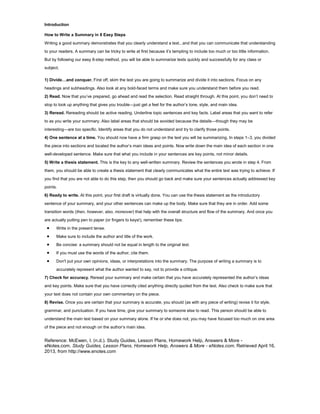
How to write a summary
- 1. Introduction How to Write a Summary in 8 Easy Steps Writing a good summary demonstrates that you clearly understand a text...and that you can communicate that understanding to your readers. A summary can be tricky to write at first because it’s tempting to include too much or too little information. But by following our easy 8-step method, you will be able to summarize texts quickly and successfully for any class or subject. 1) Divide…and conquer. First off, skim the text you are going to summarize and divide it into sections. Focus on any headings and subheadings. Also look at any bold-faced terms and make sure you understand them before you read. 2) Read. Now that you’ve prepared, go ahead and read the selection. Read straight through. At this point, you don’t need to stop to look up anything that gives you trouble—just get a feel for the author’s tone, style, and main idea. 3) Reread. Rereading should be active reading. Underline topic sentences and key facts. Label areas that you want to refer to as you write your summary. Also label areas that should be avoided because the details—though they may be interesting—are too specific. Identify areas that you do not understand and try to clarify those points. 4) One sentence at a time. You should now have a firm grasp on the text you will be summarizing. In steps 1–3, you divided the piece into sections and located the author’s main ideas and points. Now write down the main idea of each section in one well-developed sentence. Make sure that what you include in your sentences are key points, not minor details. 5) Write a thesis statement. This is the key to any well-written summary. Review the sentences you wrote in step 4. From them, you should be able to create a thesis statement that clearly communicates what the entire text was trying to achieve. If you find that you are not able to do this step, then you should go back and make sure your sentences actually addressed key points. 6) Ready to write. At this point, your first draft is virtually done. You can use the thesis statement as the introductory sentence of your summary, and your other sentences can make up the body. Make sure that they are in order. Add some transition words (then, however, also, moreover) that help with the overall structure and flow of the summary. And once you are actually putting pen to paper (or fingers to keys!), remember these tips: Write in the present tense. Make sure to include the author and title of the work. Be concise: a summary should not be equal in length to the original text. If you must use the words of the author, cite them. Don't put your own opinions, ideas, or interpretations into the summary. The purpose of writing a summary is to accurately represent what the author wanted to say, not to provide a critique. 7) Check for accuracy. Reread your summary and make certain that you have accurately represented the author’s ideas and key points. Make sure that you have correctly cited anything directly quoted from the text. Also check to make sure that your text does not contain your own commentary on the piece. 8) Revise. Once you are certain that your summary is accurate, you should (as with any piece of writing) revise it for style, grammar, and punctuation. If you have time, give your summary to someone else to read. This person should be able to understand the main text based on your summary alone. If he or she does not, you may have focused too much on one area of the piece and not enough on the author’s main idea. Reference: McEwen, I. (n.d.). Study Guides, Lesson Plans, Homework Help, Answers & More - eNotes.com. Study Guides, Lesson Plans, Homework Help, Answers & More - eNotes.com. Retrieved April 16, 2013, from http://www.enotes.com
